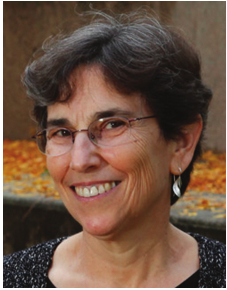PDFLINK |
Washington Update from the AMS Committee on Education
The annual meeting of the AMS Committee on Education (http://www.ams.org/about-us/governance/committees/coe-home) took place in Washington DC in late September.
Naiomi Cameron and Anne Shiu en route from the Senate to the House.

Preceding the official start of the meeting, committee members were invited to visit their congressional delegations. A subset of the committee, including the four of us, took up the offer. A busy day of visits was planned by AMS staff in the Office of Government Relations (OGR), and we hit the Hill!
Our visits were made in teams. We visited offices of members of Congress from Georgia, Massachusetts, Rhode Island, and Texas. These visits were in-person. These were—as they most often are—with staff, though we did get to briefly meet Representative Hice (GA, District 10).
We emphasized the central importance of mathematics in science and technology innovation, in education across all STEM fields, and brought their attention to particular actions they could take to support mathematical sciences education and its community. We gave each staff member a folder with an AMS calendar, a state-specific sheet about NSF investment in their own state, a few AMS Math Moments, and a “leave behind” about education prepared by OGR staff.Footnote1
AMS leave behinds are intended to serve as resources for AMS members and others in the math community interested in advocating on various topics. They do not necessarily represent the views of all AMS members.
Over the course of the day, we discovered two very important and somewhat surprising facts: congressional staff are eager to listen and learn from us and we can in fact influence policy based on our own personal experiences and those of our colleagues and students. It is possible to educate those in power about what matters and makes a difference for their constituents and nonconstituents alike.
We found it very encouraging that our arguments were received enthusiastically, and at both ends of the political spectrum—from a Democratic senator’s assistant who herself was formerly a math teacher, to a Republican congressman’s assistant who admitted to being math-phobic! A takeaway for all of us who participated is that we—as math educators—have an important role to play in driving and informing public policy on STEM education.
Another thing we learned is that many congressional offices value having mathematicians and scientists as staff members. It was explicitly pointed out to us that congressional offices would love to get more applications from undergraduate math majors for internships and other staff positions. These offices also welcome mathematicians with masters and PhDs—there are some staff members with PhDs in scientific fields, most often working for committees whose jurisdiction overlaps with their areas of expertise.
The Hill visit group debriefing on the rooftop of the AMS DC office.

There are a LOT of young people working on Capitol Hill, and their education, skills, training, and other experiences are tremendously impactful in informing the work of members and committees of Congress. As faculty members, we should draw attention to this exciting job opportunity for our students—especially undergraduate math majors—as an option for employment after college.
Current undergraduates and recent grads can serve as interns, either in DC or at the home offices. Internships are typically for a summer, or semester. They are typically paid. Each member’s website will tell you how to apply for an internship in their offices. As one example, here is the information about interning in Senator Ossoff’s office: https://www.ossoff.senate.gov/about/jobs-internships/.
How do students find these jobs?
Individual member’s and committee’s websites sometimes post jobs, but not always. Still, it is good to look at specific websites, and especially if you have ties to a district or state. In terms of general advice that you can give your students:
- 1.
Personal connections are great! Try to figure out if there are alumni from your university who have worked (or currently work) for the office in which you are interested in working. Reach out to them!
- 2.
Offices will give preference in hiring to constituents; this might especially be true at the entry level.
- 3.
You may notice that the ads say something like “Bachelor’s degree in political science, government, or a related field preferred.” This preference is not always the case; members of Congress who have committee assignments on committees whose jurisdiction include science, technology, etc., may well welcome math and other science majors joining their staff.
- 4.
MAKE SURE YOU HAVE A GREAT LinkedIn PAGE!!! And keep it up to date.
- 5.
Did we mention? Make connections and have a great LinkedIn profile.
The House of Representatives gives comprehensive information about positions with members and committees (https://www.house.gov/employment/positions-with-members-and-committees), including information and links to two separate offerings (1) the House Resume Bank and (2) the House Employment Bulletin. The Senate has the same two offerings, found at https://www.senate.gov/visiting/po.htm.
Many of the positions require only a Bachelor’s degree. You can create accounts and upload your resume in the Resume Banks, for each of the House and Senate. While requirements and organizational structure vary from office to office, “Legislative Correspondent” is an entry-level position to the legislative work of an office.
Working on the Hill can be an exhilarating experience and we hope to see more math majors consider this option!
Credits
Figures 1 and 2 are courtesy of Tyler Kloefkorn.
Photo of Malcolm Adams is courtesy of Patty Adams.
Photo of Naiomi Cameron is courtesy of Aaron Fagerstrom.
Photo of Ruth Charney is courtesy of Mike Lovett.
Photo of Anne Shiu is by Jakub Mosur/MSRI.





